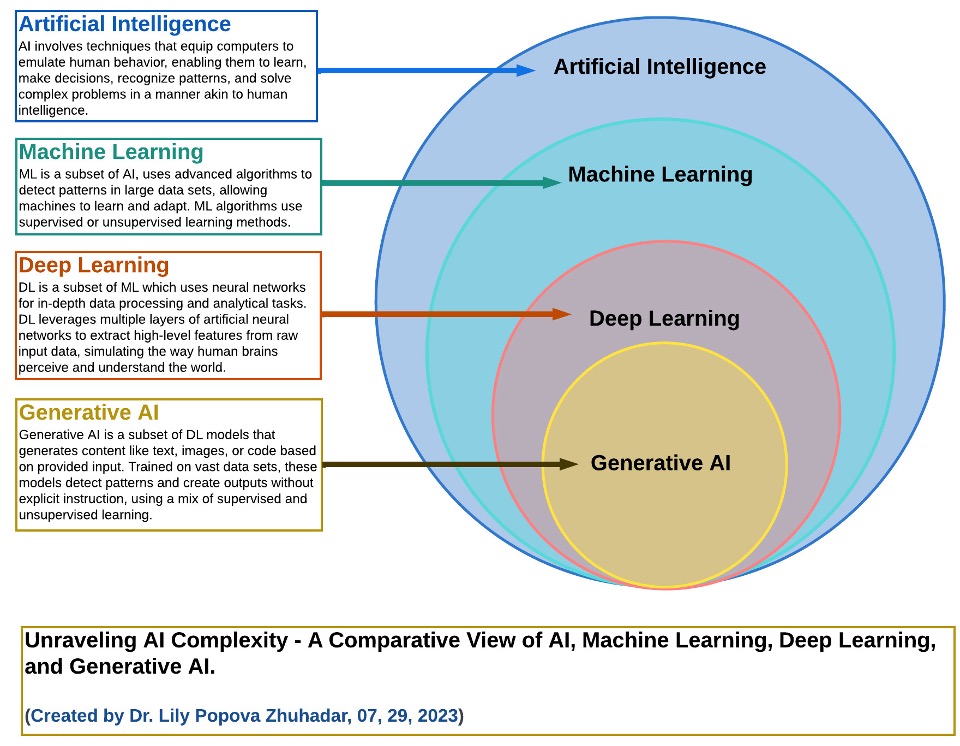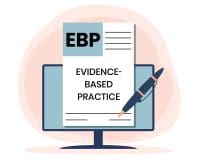I recently had the opportunity to speak about the use of artificial intelligence (AI) in writing to attendees of The Ohio State University College of Nursing Research Forum. There’s been great interest in this topic, so over the next few blogs I thought I’d share some of the information I presented.
The basics
You need to know the basics of AI before you can effectively evaluate its use in writing. Simply defined, AI is the use of computer systems to perform tasks traditionally performed by humans. Two common types of AI are nongenerative and generative. Nongenerative, or traditional, AI recognizes patterns in data, then makes predictions. Simple examples include voice assistants like Siri and recommendations on Netflix. As the name implies, nothing new is created.
Generative (or Gen) AI, on the other hand, generates new content and is the focus of this blog. You can use GenAI to improve writing, conduct research, analyze data, and much more. The image below illustrates some of the elements of AI, including GenAI.


Source: PopovaZhuhadar, CC BY-SA 4.0, via Wikimedia Commons
Machine learning, a subset of AI, uses advanced algorithms to detect patterns in large datasets. Deep learning is a subset of machine learning, and GenAI is a subset of deep learning. (Another term you’ll hear about is natural language processing, which allows computers to understand human text and speech.)
The large language model (LLM) is a type of GenAI. Both LLM and GenAI use artificial neural networks and massive amounts of data to train the computer tool, but other training methods differ between the two. GenAI and LLM are sometimes used interchangeably; however, although they both generate new content, they have slightly different capabilities. On a basic level, LLM is more focused on text, while GenAI has applications beyond text, such as image, video, and audio generation.
I’ve intentionally kept this explanation simple. After all, we drive our cars without fully understanding what goes on under the hood. However, it’s important to know certain basic facts, such as the use of large amounts of data to train systems, so that you can better understand AI’s limitations, which I’ll discuss in the next blog.
Possible uses of AI in writing
Although you’ll learn about AI’s limitations, I want to note that it also can help you in your writing endeavors. A review article by Khalifa and Albadawy identified six areas where AI enhances academic writing: idea generation, content structuring, literature synthesis, data management, editing, and ethical compliance. It also may be helpful for those for whom English is a second language. This help could facilitate wider dissemination of work by researchers who frequently feel hampered by the English-dominated publication process. Finally, AI may save you time—perhaps the most valuable benefit!


I’ve been a full-time professional nurse writer and editor for many years, and that doesn’t count the writing I did as I fulfilled my nursing roles in clinical, research, education, and management. My passion is helping nurses share their expertise through the written word, including, but not limited to, publication. Writing can be scary and intimidating. I hope to make it less so and to help you develop your writing skills the same way you’ve developed your nursing skills.
Whether you’re considering your first or your 50th publication, want to contribute to your organization’s newsletter, or crave to be a better communicator online and in print, I hope you’ll find what I write helpful. The nurse publishing colleagues I’ve learned from over the years (many of whom are contributors to my book) may not be listed by name, but I’m grateful for their willingness to share. In that spirit, I’m looking forward to sharing with you! If you have feedback, feel free to email me at csaver57@gmail.com.
References
Buriak JM, Akinwande D, Artzi N, et al. Best practices for using AI when writing scientific manuscripts. ACS Nano. 2023;17(5):4091-3. doi:10.1021/acsnano.3c01544
Craig L. Compare large language models vs. generative AI. Tech Target. February 29, 2024. techtarget.com/searchenterpriseai/tip/Compare-large-language-models-vs-generative-AI
Khalifa M, Albadawy M. Using artificial intelligence in academic writing and research: An essential productivity tool. Comp Meth Prog Biom Update. 2024;100145. doi:10.1016/j.cmpbup.2024.100145
Martin K. AI language models are transforming the medical writing space – like it or not! Medical Writing. 2023;32(3):22-7.
Nguyen T. Large language models vs generative AI: The differences you should know about. Neurond AI. June 21, 2024. neurond.com/blog/large-language-models-vs-generative-ai


















